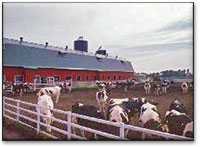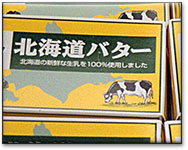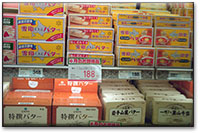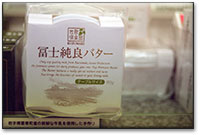Related pages:
Countries ·
India ·
Arab world ·
Tibet ·
China ·
Japan ·
Russia ·
| |

Japan's best milk and butter come from the northern island of Hokkaido, where dairy farming is said to have begun in Hakodate city in 1857.
|
Butter is not a traditional part of the Japanese diet, though it has become common since the 1960s, when westernisation of the Japanese diet increased the demand for milk and dairy products. Japan now consumes nearly 90 million tons each year, or about 0.8 kg per person. That is about a third of what Americans eat, and a tenth of the French or Germans.
It was not until the mid 19th century that that dairy was common in Japan.
Prior to World War II, Japanese contact with the West had been at a minimum. When they came in contact with the Portuguese in the sixteenth century and the more numerous English and Americans in the 19th century, they reacted with shock. The blue eyes and “red” hair of westerners are attributes of goblins in Japanese folklore. They were appalled at the hairy, sweaty bodies that gave off a strong body odor due to a diet higher in animal fat. Those who did meet Europeans were disgusted by their stench: people who seldom touch animal products are extremely sensitive to the body-odor exuded by eaters of animal fat.
It was butter, the Japanese thought, which made Europeans so peculiarly rank: bata-kusai they called them (using the English word for the foul substance): “butter-stinkers." The terms Bata-kusai, “stinking of butter,” is still a derogatory term for things obnoxiously Western.
In the latter 1800's, "Ayrshire," and later Holstein-Friesian cows were imported. Then, in 1923 Hokkaido invited dairy farmers from Denmark to show them how to run a dairy operation, after which dairy farming became an established industry.
Help grow this exhibit with your photos! WebExhibits helps connect people and cultures, and you can join in by sending photos of butter from your part of the world. Read more about sharing your photos.




